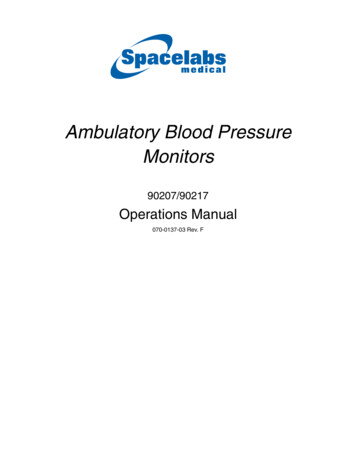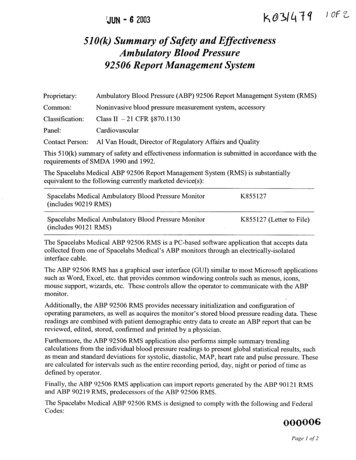
Transcription
Title: Blood Pressure Measurement: Should Technique Define Targets?Research team:PI: Marcel Ruzicka, Division of Nephrology, The Ottawa HospitalCo-PI: Swapnil Hiremath, Division of Nephrology, The Ottawa HospitalCo-investigators:Cedric Edwards, Division of Nephrology, The Ottawa HospitalTim Ramsay, Methods Centre, OHRIStudy Budget: 45,000Funding Body: Physicians Services IncorporatedStudy Duration: September 2017 – Aug 2018Version 1.0July 6th 2017
Lay SummaryHypertension is the single most important risk factor for cardiovascular disease and death. Overthe last several decades many classes of blood pressure lowering drugs have been discovered.These allow physicians to achieve optimal blood pressure and prevent adverse cardiovascularoutcomes in most patients. However, the optimal blood pressure level has changed over time,and most recently has been decreased to 120 mm Hg, on the basis of clinical trials. These trialsused a specific rigorous method of blood pressure measurement (patient alone in room,enforced period of rest, average of multiple readings) that is currently not the standard ofpractice in most clinics. Blood pressure itself is highly influenced by technique and device. Inparticular the length of resting time (if any), and whether it is measured with device requiringmedical personnel presence in the room or not. For the same individual, the differencebetween blood pressure taken with and without rest could be 10 mmHg, and presence vsabsence of medical personnel in the room during rest and/or BP assessment could be another10 mmHg. Hence, the target blood pressure could vary materially based on BP technique anddevice used. As it is unlikely that all physicians can change their practice overnight and embraceblood pressure device allowing for standard resting time and unattended blood assessment, acomparative pragmatic study of the blood pressure technique and devices endorsed byHypertension Canada and used in Canada is desirable to avoid either over- or under-treatmentof Canadian patients with hypertension. In the present study, we will compare 4 differentmethods of measuring blood pressure in the office (casual, resting average of 3 readings withnurse present of absent for resting period, and average of 5 readings) as well as a 24 hourambulatory measurement in 90 patients.The results of this study will help and enable practicing family physicians and specialists inCanada to target BP for their patients based on algorithm and method of assessment of BP theyuse in their offices.Version 1.0July 6th 2017
BackgroundHypertension prevalenceHypertension is a chronic disease with a tremendous burden. Its prevalence is estimatedglobally at about 20%, with an increasing trend continuing in the last 15 years(1). Hypertensionis highly prevalent among adult Canadians (at about 26%). The prevalence of hypertensionincreases from about 4% in young adults ( 30 years of age) to more than 50% among those 60years of age and older. Altogether, hypertension is extremely relevant vascular disease amongadult Canadians.Hypertension and Clinical OutcomesHypertension is the single most important risk for adverse vascular outcomes, comprisingstroke, heart disease, and both cardiovascular and all-cause mortality. The estimated annualdeath rate per 100 000 associated with systolic BP of 140 mm Hg or higher is about 106(1). Thelargest numbers of hypertension related deaths were caused by ischemic heart disease (4.9million; 54.5%), hemorrhagic stroke (2.0 million; 58.3%), and ischemic stroke (1.5 million;50.0%)(1). Loss of disability-adjusted life-years (DALYs) associated with systolic BP of 140 mmHg or higher are estimated to be about 143.0 million US dollars(1). Treatment of hypertension,using randomized controlled trials (RCTs), showing repeatedly that the risk of these adversevascular outcomes is decreased by sustained blood pressure (BP) lowering.Advances in Pharmacological Treatment of HypertensionBack in 1940, patients diagnosed with hypertension had very limited treatment options: eitheran extreme low salt diet and/or dorsal lumbar sympathectomy, both very radical measures,reserved for individuals with malignant hypertension, at what we would now considerextremely high blood pressure levels (with target organ damage). Over the last 75 years, morethan 7 different classes of BP lowering drugs have been discovered. Hence in the modern era,almost all patients with hypertension can have BP level decreased to desired numbers. Hencethe research focus has moved from how blood pressure could be decreased, to how muchblood pressure should be decreased, and in whom should these targets apply.Blood Pressure Treatment TargetsTargets for BP have been largely established based on results from prospective observationalstudies, which show a progressive rise in adverse cardiovascular outcomes from the levels ofsystolic BP above 120 mmHg with a steep rise with systolic BP above 140 mmHg. RCTsconfirmed these findings and showed that decreasing BP below 140 mmHg in the generalpopulations, 150 mmHg in the very elderly patients, and 130 mmHg in patients with diabetesmellitus significantly reduces adverse vascular outcomes such as stroke, chronic heart failure,myocardial infarction, and mortality. Recently, new trials tested the hypothesis of whetherpatients with the highest cardiovascular risk benefit from even lower targets of systolic BP(2).Version 1.0July 6th 2017
The Systolic Blood Pressure Intervention Trial (SPRINT) and its relevance for BP target inpatients with high cardiovascular riskIn this prospective, randomized controlled trial funded by NIH, patients with highcardiovascular risk (Framingham Cardiovascular Risk Score 15%, average 21%) wererandomized to standard treatment targeting systolic BP 140 mmHg or to intensive BPlowering regimen targeting systolic BP 120 mmHg(2). This trial, with 9,361 patients, wasstopped early after an average follow up period of 3.2 years after patients randomized to theintensive BP lowering arm experienced a clinically significant decrease in primary outcome(comprising of stroke, acute coronary syndrome, congestive heart failure, and cardiovasculardeath). Following this development, a new target of systolic BP 120 mm Hg for patients withhypertension and high cardiovascular risk has been recommended by major nationalprofessional organizations including Hypertension Canada/Canadian Hypertension EducationProgram, in their most recent Guidelines on the Diagnosis and Treatment of Hypertension(3).However, in the discussion around the benefits and risks of more intensive BP lowering,insufficient attention has been focused on the method of BP measurement in SPRINT, and howit compares to existing methods(4).Which BP reading is the most relevant to predict adverse vascular outcomes?Over the years it became clear that a single office BP reading provides only a snapshot of theoverall BP load. As expected, repeated office measurements of BP provide better assessment ofBP load and overall adverse hypertension related vascular outcomes. 24 hour ambulatory BPmonitoring (ABPM) provides the ultimate assessment of overall BP load during the daytime andnighttime. ABPM allows for identification of white coat effect (out of office BP is lower thanoffice BP) and masked effect (out of office BP is higher than office BP). Measurement of thediurnal variation also allows for identification of nocturnal blood pressure. The averagenighttime BP appears to be the single most important predictor of adverse vascular outcomes,followed by average daytime BP, and repeated office BP recordings. ABPM is, however, not aninsured service covered by the provincial health insurance in Ontario, or the rest of Canada.Finally, home BP measurements, in combination with repeated office BP readings, have alsobecome more commonly used now. But home BP is not used by all patients, there is anadditional cost involved, and home BP monitors may not be accurate. In the real world, hence,office BP readings remain the most commonly method used for diagnosis and the managementof hypertension. Hence it is crucial that accurate methods are used for office BP measurements.Automated oscillometric BP devices replaced mercury sphygmomanometryMercury sphygmomanometry was, for nearly 100 years, the most commonly used techniquefor office BP assessment. However, readings using this technique are not as accurate andreproducible as one may have thought. Firstly, accuracy is highly dependent on the skills ofVersion 1.0July 6th 2017
health care professional, and is not only susceptible to human error and listening skills, but alsoto terminal digit preference (rounding to ‘0’). Secondly, at least 20% of patients display higherBP readings with health personnel in the room than in real life (white coat phenomenon).Additionally, about 10 - 20% of patients have lower BP readings in the office than in real life(masked hypertension). Automated oscillometric BP devices (AOBP) eliminate the human erroras well as attenuate the white coat effect, since they allow for multiple readings to be taken in(un)attended fashion. Observational studies have reported that BP measurements with AOBPdevices are predictive of cardiovascular events. Because of these two major advantages,Hypertension Canada recommends automated oscillometric devices as the method of choicefor office BP measurement. In the last decade, AOBP devices, which typically provide anaverage of 3-5 measurements, have become widespread for use in specialist clinics, and,especially, in general practice. Several features of automated measurements are noteworthyand relevant for further discussion.Relevance of human error and presence of medical personnel for BP readingsEven trained medical personnel are prone to round up or down actual BP readings to theclosest zero (5, 6). Automated oscillometric BP devices eliminate this error(7, 8). In addition,they mitigate a risk for human error related to variable training, and hearing deficit (6-8).Furthermore, the presence of medical personnel during BP readings imposes a positive bias onBP, the ‘white coat effect’. This effect may differ from person to person, likely related to varyingsusceptibility for white coat effect between patients (4, 9). By contrast, automated oscillometricdevices allow for BP assessment in an unattended fashion. Not surprisingly, the differencesbetween office BP readings taken by automated oscillometric devices and mercurysphygmomanometers can be relatively large. For example, Myers et al reported a positive biasfor BP readings taken by manual measurement of 13.9 mm Hg, compared to the automatedoscillometric device(10). Other studies, including those by our group, concur with thisimportant degree of positive bias imposed by human error and presence of medical personnelin the room during BP readings (11, 12). Finally, casual BP readings taken immediately afterpatient arrival to the office, without prior resting, are also materially higher compared to thosetaken after a rest period. In the recent study by Agarwal, systolic BP readings by using thetechnique and the same device employed in SPRINT were 12.7 mmHg lower as compared tosingle office non-resting office BP reading taken by another oscillometric device, in thepresence of a medical personnel (13). Indeed, the presence of another person who is talkinghas been reported to result in a positive bias ranging from 4 – 19 mm Hg in systolic BP (6). Inaddition, just the presence of a health personnel (who is not talking) as well as the hospitalenvironment itself are the major component of the white coat effect (14). The automateddevices attenuate this effect by virtue of allowing (a) unattended BP measurement and (b)taking an average of multiple readings.Version 1.0July 6th 2017
12345MethodCasual bloodpressureDetailsFirst BPmeasured aspatients walksinto the clinicResting Blood pressure methodsBPTruBPTru deviceNo extra periodof rest1st reading byNurse, wholeaves room5 additionalreadings 1-2minutes apart,output average of 5Omron HEM OMRON HEM 5 minutes of907XL, partly 907XLunattendedattendedrest,Nurse entersroom3 BP readings,output averageOmron HEM OMRON HEM 5 minutes of907XL,907XLunattendedunattendedrest,3 BP readings,output averagePatient alone inroomthroughoutAmbulatory Blood pressureABPMMany devices, Oscillometriceg Spacelabsdevice; left onfor 24 hours.Records every30 minuteswhile awake, 60minutes whenasleepVersion 1.0DeviceOscillometricdevice, rarelymercuryCommentsCan beartificiallyhigh (whitecoat effect)DifferenceReferenceReduceswhite coateffectAssociatedwith CVoutcomes.Commonestmethod usedin Canada 5-8 mmHg lowerMethod usedin SPRINT 12 – 13mm HglowerBP trendHigherNot known,? 15 mm HgLowerLinked to CVoutcomes;diagnosis ofwhite coatand maskedeffect; showsdiurnalvariation inBP 5 mm HglowerJuly 6th 2017
Resting time and Blood Pressure levelsIdeally, BP measurement should be done after a 5 minute period of rest, as perrecommendations and best practices. Indeed, insufficient rest period can result in a positivebias ranging from 4.2 to 11.6 mm Hg(6). Unfortunately, in the real world setting, properresting is rare, and results ‘routine’ BP measurement were reported to be higher by 5.3 mm Hgcompared to properly done resting BP(15). Importantly, the longer the rest, it appears, thelower the BP readings, even beyond the normally recommended 5 minutes. In this regards,Nikolic et al compared BP readings taken by automated oscillometric BP device after 5 and 10minutes of rest (16). Readings after an additional 5 minutes of rest were lower -4.2 mm Hg. Thisstudy indicates that the number of minutes of rest prior to BP readings could indeed have aclinically meaningful impact on the result, above and beyond the ‘normal’ resting period of 5minutes. Until recently, it was left up to medical personnel to assure that BP readings weretaken after 5 minutes of rest. While there are no studies on quality assurance in
BP load and overall adverse hypertension related vascular outcomes. 24 hour ambulatory BP monitoring (ABPM) provides the ultimate assessment of overall BP load during the daytime and nighttime. ABPM allows for identification of white coat effect (out of office BP is lower than office BP) and masked effect (out of office BP is higher than office BP). Measurement of the











